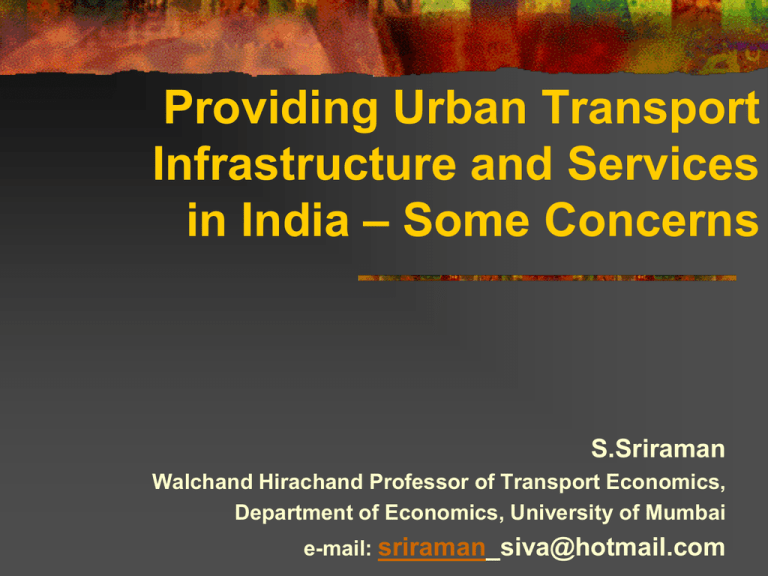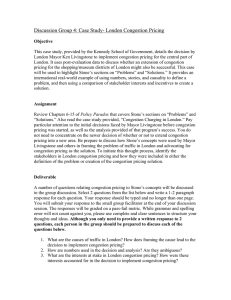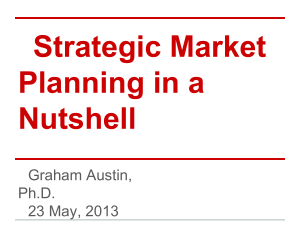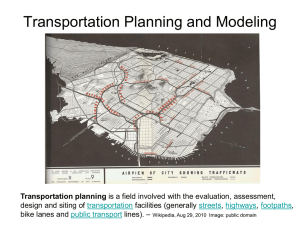Transport in Mumbai – Critical Issues and Emerging Options
advertisement

Providing Urban Transport Infrastructure and Services in India – Some Concerns S.Sriraman Walchand Hirachand Professor of Transport Economics, Department of Economics, University of Mumbai e-mail: sriraman_siva@hotmail.com Features of Urban Transport in Developing Countries • An estimated 5% to 10% of urban household income is spent on transport -- and more than 25% for the poorest households in very large cities • 15 to 25% of city budgets is typically for transport • One third of city infrastructure investment is for transport especially roads • Even though private capital is now getting involved in the financing of urban transport infrastructure, most investments will still have to come through the city budget. Some traffic features in our Cities (WSA, 2009) The share of personalized modes especially of two wheelers have gone up leaps and bounds clocking 12% per annum in the past two decades, Sharp decline in the share of public transport over the past two decades. Some public transport services have been even pushed out of business. Operating bus services in congested streets have become increasingly difficult in congested networks with turn around times increasing by the day. Fleet sizes in nearly all public bus undertakings have declined rather than grow to meet the demand . Consequently street congestion has dramatically increased and overall speeds on major corridors have dropped. Some traffic features in our Cities The trip rate in almost all city categories have increased as expected. With the increase in the sprawl of the city, average trip lengths have naturally increased. Average journey speed on major city corridors during peak hour (KMPH) is 23 Forecast of Average Journey Speed by (KMPH) during peak hour would be 7.6 in 2013 (BAU scenario) Some traffic features in our Cities the decline of Non Mot.Tr. especially cycling. Congestion, increase in trip lengths due to urban sprawl, increase in purchase power of people and totally inadequate facilities for cycling have all contributed to reducing cycling. - And for pedestrians our city roads have simply forgotten they exist. The percentage of roads with pedestrian footpaths runs to hardly 30% in most cities KEY CONCERNS Population – Its growth and spread (city size) Urban Transport Patterns Public (Mass) Transport – Role Personalized (Motorized) Transport- Role Implications – Reduced Access, Congestion, Pollution, Mobility of Urban Poor Goods mobility issues Limited Choices before us Population – its Growth and Spread Size of Cities – Much more than economically considered optimal. City sprawls further and faster- concept of sprawl- high dense and not low dense. Problems suggest that urbanization problems are complex and that the current approach to urbanisation which is different from the past needs to be adopted to provide meaningful solutions. Are we looking at it afresh? This is looking at purely from provision of infrastructure – not much emphasis on this earlier. Urban Transport Patterns Major influences on transport patterns at the city level that are identified in the literature include: Interaction of transport and urban form and use and influence of urban planning policy Infrastructure Investment Choices Income Changes, Motorization, and Household location choices Prices and Economic Instruments Institutional Urban Planning and Transport Planning NUTP talks of little integration between the two ‘’ transport planning has not received the extent of attention it should have in drawing up strategic development and land use plans’’ Development plans are not implemented in any systematic way Worse, ad hoc decisions related to FSI redevelopment), etc, which endanger any sort of transport planning that is possible Infrastructure Investment (Public Transport) Almost everywhere – public transport systems not planned Public transport investments thoroughly inadequate Consider Mumbai- virtually no investment since the 1960s till now Similar situation in other cities especially lower tier cities. Infrastructure Investment (Private Transport) Basic Inability of Public Transport to meet needs Increasing Incomes, vehicle ownership, Focus on Roads expansion- elevated roads, flyovers, etc. –useful for private vehicles with only very limited, effective attempts to use road space well with bus lanes, BRTS, etc. Infrastructure Investment (NMT) Cycling and walking –Millions of short trip made even today but very unsafe NUTP lays a lot of emphasis on NMTbicycling and walk mode Investments made on these in recent years at the wrong places or are in the sky (skywalks) – many examples can be cited. At some places, we need to take a vehicle to cross a road Pricing Issues Pricing of urban transport has always been arbitrary- case studies of BEST, Mumbai suburban rail system, PMPML, TN Urban SRTUs, etc. Today, very little attempts made to reform pricing systems under the guise that no urban transport system can escape subsidies. A related matter is efficiency of operations which is no one’s business. With no benchmarks, no efficient system of prices can emerge. Pricing Issues (cont’d) While basic issues are not sorted out, congestion pricing schemes are being extensively talked about, those that can serve only as complements to main pricing ones. The Mumbai suburban case – low tariffs (based on IR ordinary passenger tariffs) , operations profitable (due to super crush loads) but at high social costs Increase in fares can help but additional revenues hardly ever come back to the system due to existing institutional arrangements. Institutional Arrangements (Operations) Traditionally, state provision in public bus transport almost everywhere except some States Failure of SRTUs due to many factors Some reforms in the late 1990s and early 2000sderegulation- with entry of private sector- some success – but limited and highly inadequate No attempt to follow example of some states which had private sector operators competing with public sector and the regulator playing a useful role. Institutional Arrangements (Operations)(cont’d) Under NUTP: PPPs encouraged Carried forward under JNNURM Even in a more general context, PPPs have not been defined properly. Neither the public entity nor the private entity concerned understands its responsibility fully. People also do not know what to expect Experience in Maharashtra – not good Institutional Arrangements (planning and regulation) Under NUTP- UMTAs are to be in place As of now – everything is on paper Nothing really being taken forward except for local level coordination being attempted as in MMRDA which handles UMTA officially Reflects situation at the national level – where no serious macro level coordination takes place A moment on ‘’urban goods mobility’’ Focus of whatever is planned on people’s mobility very little consideration of proper movement of goods in urban areas Confined to a few hours at night and this is also done very arbitrarily Huge numbers of heavy vehicles held up outside urban areas for hours A moment on ‘’urban goods mobility’’ (cont’d) Only small goods vehicles are allowed – adding to the congestion and pollution (being followed in case of inter-city buses especially those belonging to the private parties which are stopped outside and passengers moved to smaller vehicles to go into the city) Distribution of goods is hindered and truck capacity is wasted Choices before us Look at sprawl of cities and attempt to limit city sizetransport plans would be far more useful then. Sort out basic pricing issues and then use of other pricing instruments– inherent is the concept of demand management Emphasis only on investments to build up public transport systems capacity To insist on good pedestrian paths on every section of the road Coordination of planning and operations a must Thank You











